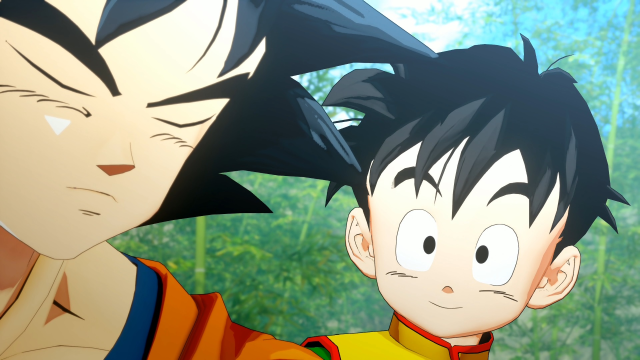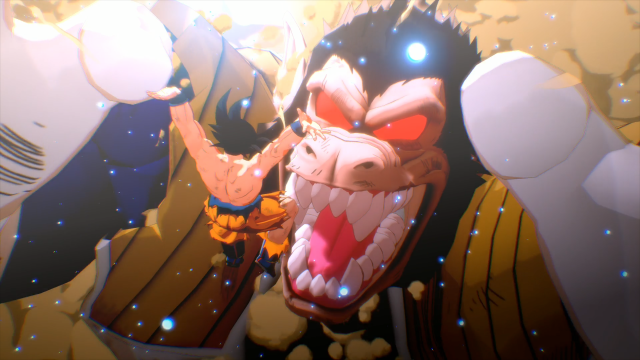Dragon Ball Z: Kakarot is an action-RPG that puts you in the shoes of the Z fighters as they battle there way through the stories told within the Dragon Ball Z universe.
That means fighting off Radditz, Vegeta, Frieza, Cell, and Majin Buu. As any fan of the series knows, those are a lot of stories to get through, so it’s safe to assume Kakarot will be a sizeable game.
While we’ve played through these stories a good few times at this point in other titles, it’s generally been in the arena of a fighting game, which makes Kakarot‘s genre change rather exciting.
Charging Up for Half an Hour

Throughout this preview, I’m going to be purposefully vague to avoid spoilers. What I do want to say is that I recently got to play through the opening hours as well as the dying moments of the Saiyan Saga, and overall, I had a lot of fun.
The first thing worth noting is that Dragon Ball Z: Kakarot looks incredibly pretty. Anime games are finally reaching a point where they look like the shows they’re based on, and Kakarot is no exception. The animations are gorgeous, the worlds are vibrant, and the super attacks look, well, super. It’s all very lovely.
Kakarot kicks off at the beginning of Dragon Ball Z. This means Kid Gohan. These opening moments serve as your tutorial. Exploring the big, open areas is a lot of fun thanks to the ability to run, fly, and ride vehicles. You can move at incredible speeds because getting from one place to another would take hours otherwise. Kakarot‘s world is incredibly large.
A Filler Involving a Meal

Along the way, you can fish, find fruit, hunt, and cook. You can whip up meals that will boost your stats for a little bit, but also make some that will permanently increase your stats as well. This should come in handy when the battles get really tough later on.
You will also come across plenty of sidequests to undertake too, many of which (at least in the early game) have references to the original Dragon Ball story. Completing these side quests allows you to gain extra materials, experience points, and even the occasional community member.
You see, you can boost your cooking chops, mechanical skills, or fighting abilities (as well as a lot of other intangibles) by making connections with other people. You will get a pin that represents them, and then earn boosts for putting these pins into Kakarot‘s various boards. You can even gain extra boosts depending on the character.
For example, having Goku and Gohan on the combat board allows you to boost your combat prowess. It’s an intriguing take on stat-boosting that should incentivize players to take on sidequests to get stronger.
Not only do sidequests unlock new community members, but they can also net you more Z Orbs, which can also be found while exploring the world and from battle rewards. You use Z Orbs to unlock new special abilities from your Skill Tree.
Each character has their own tree, and many of the abilities can only be unlocked once you’ve completed certain missions. Overall, the system seems to be a good way of stopping you from becoming too powerful, at least when it comes to skills.
A Flashy Fight Scene

If you wanted to spend a few hours grinding in Kakarot, you could easily do so by fighting the abundance of wandering enemies that populate Kakarot‘s open areas. You can fight against these to your heart’s content, although I did accidentally blow one up simply by flying past it, so it could well be that fodder enemies simply stop fighting you once you’re too powerful.
Good news, though: I also stumbled into some enemies three times my level, and they ruined me. That’s the kind of nonsense I like to see in an ARPG, and hopefully, it will be present throughout.
Kakarot‘s battles are a lot more Dragon Ball Xenoverse than Dragon Ball FighterZ, but that’s not a bad thing. You fight in huge arenas and can fly around freely. You can also perform basic melee and ki attacks, as well as charge up to unleash your super moves. You’ll even be able to activate transformations, too.
While the battle system seems basic at first, there are a few deeper levels to uncover thanks to the differences between special attacks, status effects, and even just when deciding to dodge or guard.
It’s a fun and functional battle system that should have players enjoying their time with Dragon Ball Z: Kakarot, but it’s important to note that this isn’t a fighting game. The aim isn’t to be complicated but accessible. A lot of the complexity comes from the wealth of systems to mess around with.
—
I had a lot of fun with my time with Dragon Ball Z: Kakarot, and I’m incredibly hopeful for the full-game now. It’s just a matter of whether or not it can keep a better pace than the series itself.
Dragon Ball Z: Kakarot is set to release for PC, PS4, and Xbox One on January 17, 2020. Stay tuned to GameSkinny for more news and info on the game, as well as our review early next year.







Published: Dec 4, 2019 07:01 am